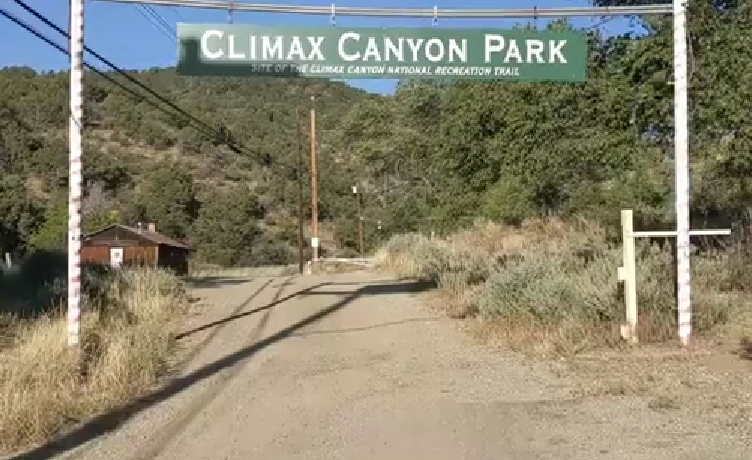Welcome to a potpourri of fun! On this page you’ll find the latest comics by Jari Thymian, a motivational quote, a crossword puzzle contest, and whatever else we decide to throw in here. Be sure to check back for the latest!
- Earth Corner – With Pat Walsh
- Star Stories – by Kelly Ricks
- Riding the Santa Fe Trail – by Laura Brewer
- Every Day Should be Earth Day – Editorial by Laura Brewer
- Find the Differences
- Frank Mahannah – Gallery
- Exploring Climax Canyon by Mauricio Meneses
- Madi’s Kitchen
- Quotes & Riddles
Quotes & Riddles



Earth Corner – With Pat Walsh
Bear Controversy
Posted May 14, 2025
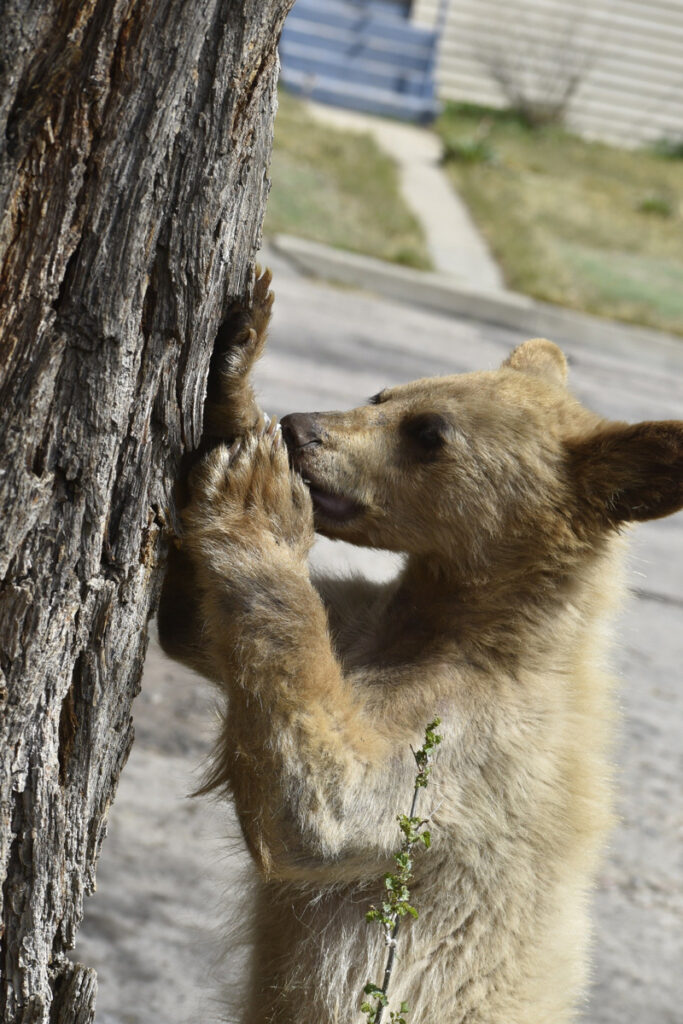
Many Ratonians understand that feeding a black bear usually leads to the bear’s death. After reading online posts about a local bear that was killed, I’m grateful that most locals know how to protect wildlife.
Now a confession.
When I moved here in 2005 to work for N.M. State Parks, I returned from a shopping trip to Colorado and left a bag of cat food in my car. The windows were cracked, a hot-weather habit of mine. That night, a bear put its claws into the gap, shattered a window and chowed down on cat food, probably ingesting some glass fragments as well.
I felt horrible. I knew you should never, ever feed a bear—even accidentally. Soon after, a large bear was killed for posing a danger at a nearby house. If it was the same bear, I contributed to its death.
Recently, a new Raton resident posted he was upset that wildlife officers killed a young blonde bear, which he said he had fed by hand. This apparently was the same bear photographed at dumpsters and featured in online posts.
But when the bear briefly got into a resident’s house through a doggie door, wildlife officers followed safety protocols. They found, tranquilized and killed the bear, according to N.M. Game and Fish communications director Darren Vaughan.
The bear was not deterred by the presence of humans and was “posing a threat to human safety,” Vaughan told me. “Crossing a threshold into someone’s house, whether it’s a bear or a human, is a threat to someone’s safety.”
And while bears can cleverly get into cars and houses, they may get stuck and panic. I wouldn’t want to face a scared wild bear in my house, even a youngster. I wouldn’t want my pets at risk, either. Plus, a small bear will turn into a big bear that associates people with food.
Still, I mourn that little blondie.
The man who admitted feeding the bear took lots of grief online. I’m glad so many Raton residents understand that “A fed bear is a dead bear.” But I can sympathize with his desire to help a young wild animal. And odds are, he wasn’t the only one who made the bear dependent on people. If this bear got into a dumpster, it’s because someone didn’t close the lid properly. I’ve seen this all over town.
When I gave programs as a park ranger, I showed people bear scat that I’d collected near Raton. The scat contained plastic wrappers and cigarette butts. Bears can’t sort food from trash, which can fatally clog a bear’s digestive system.
So let’s close dumpster lids, bring pet food inside, take down hummingbird feeders at night, and never leave trash out.
This past week, I spotted a beautiful chocolate brown bear walking up my street and heading into the woods. Traditional indigenous culture holds that we are related to all of nature. I am not indigenous, but I hope my bear relative stays in the woods and lives a long, long life.

Star Stories – by Kelly Ricks
Polaris Galacticus Borealis
Posted April 10, 2025.
Many of the stars and constellations that stick in our memory are those that line up with how we and our solar-system companions are oriented in space.
The constellations of the Zodiac are very well known, but anyone who has tried to decipher Ares, Aquarius, Cancer, Capricorn, Virgo, or Pisces knows that these patterns of stars are dim and don’t really resemble their intended characters. The reason these constellations are famous is because from our vantage point they happen to lie directly behind the flat plane of the solar system. From day to day, month to month, and year to year, we watch the Moon, Sun, and planets wander in front of them…and only them. Canes Venatici (The Hunting Dogs) will never catch Jupiter’s scent. You’ll never watch the moon fly with Cygnus (the Swan). And no matter how hard she might wish it, the vain queen Cassiopeia will never seize the sun for her throne. By knowing the zodiacal constellations, it’s relatively easy to orient ourselves within the solar system.
Polaris, the north star, is not particularly bright either, but like a spinning top, Earth’s northern axis happens to point straight toward it (at least within our lifetimes). As the one star that appears stationary while all others circle around it, it’s both a reliable tool for navigation, and a powerful cultural metaphor of steadfastness. High in the springtime night sky there’s another unassuming constellation that holds an anchor within: another pole star, another guidepost, and another—deeper—perspective on our orientation within the universe.

One of the few zodiacal constellations that does resemble its namesake is Leo. With a “backward question mark” as its mane, this majestic lion guards his stellar domain like a sphynx. Following close behind is a dim trio of stars: a “right angle” that almost looks like it could make a square with Leo’s tail and hind quarters. “Coma Berenices” (Berenice’s Hair) was named for Queen Berenice II of Egypt who lived in the mid 200s BC, and is the only modern constellation named for a real person. Berenice was renowned for her beautiful amber-colored hair, but when her husband King Ptolemy III went to war, she offered her tresses to Aphrodite in hopes that the goddess would bring him safely home. Ptolemy did indeed return, and Berenice’s loving sacrifice was memorialized in a constellation showcasing a long cascading cluster of stars.
| “Coma Berenices” from “Overlooked Constellations.” DeepSkyKelly.com |
Berenice’s starry “hair” is indeed beautiful, but to me its most awe-inspiring feature is that it visually anchors the Milky Way’s North Pole. That’s right. Just like Earth, our immense galaxy—with its billions of stars, planets, moons, and vast clouds of gas and dust—spins on an axis, and from our view on Earth’s northern hemisphere, that axis points to a faint star in Coma Berenices called “Polaris Galacticus Borealis,” the Galactic North Pole.
When Coma Berenices is straight overhead (around midnight in April, and 11:00pm in May) the Milky Way is not visible in the sky. This confuses—and sometimes frustrates—early-season dark-sky enthusiasts who visit our area in search of the Milky Way. But if you stand with your arms spread parallel to the ground and turn in a slow circle. The disc of our galaxy is surrounding you on all sides of the horizon! When you look up, you are looking straight out of our galaxy and toward many clusters of galaxies far beyond the Milky Way. If you continue to watch through the morning’s wee hours, you’ll see Coma Berenices and the Galactic North Pole set in the west as the brightest part of our galaxy surges above the eastern horizon before dawn.
Spring is “Galaxy Season.” The Virgo, Coma, and Leo galaxy clusters contain thousands of galaxies—dozens of which are visible with a modest-sized telescope (8-inches in diameter or more). There are so many to see in such a small area that amateur astronomers tear out their hair trying to figure out which one is which. But simply standing beneath Coma Berenices and “straight and tall in our galaxy,”* it is easy to feel part of something grand: to breathe deep within the vastness, and feel welcomed into eternity.

*From “Stars above, Earth Below” by renowned astronomer, author, and artist Tyler Nordgren

Help our Earth – Editorial by Laura Brewer
Every day should be Earth Day, but officially we celebrate in the U.S. on Monday, April 22, 2024. Below is a graphic of some of the things one can do to help our Earth.
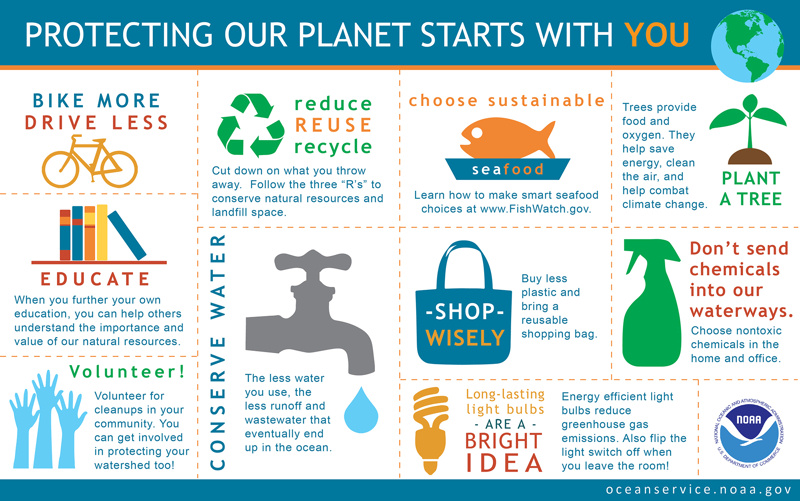

Posted March 9, 2025 – Provided by Laura Brewer
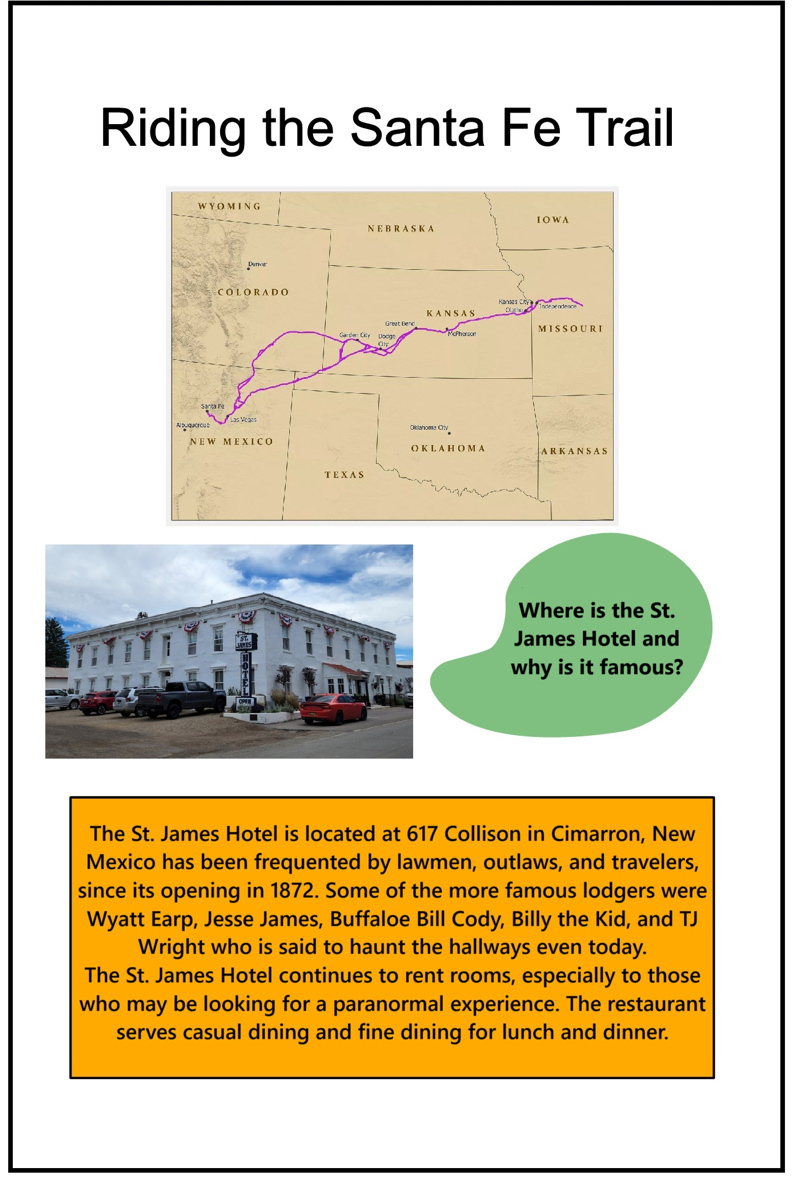

Madi’s Kitchen
See additional recipes on Madi’s Kitchen page
Cherry Jellies
Posted May 14, 2025
Now that we are officially in May, that means anime recipes all month! Anime is a style of Japanese film and television animation. To kick this month off I decided to do a jelly again, this time instead of a coffee one, I have a cherry jelly with a panna cotta and sugar cookie base. These were served at the party we had at our farm last week along with an elderberry one.
Everyone really enjoyed them, and they went amazingly fast. Luckily, I had extras of each one that I put in the fridge for myself to eat when everyone was gone. Just like the coffee jelly these are quite simple and don’t take much time other than letting them set. These do have one other element that you do have to watch out for, which is the panna cotta. You need to be careful not to burn while you’re heating it up. I personally didn’t have any trouble with this step. I just made sure to stir it often and not let it go past boiling. It could definitely burn easily if you don’t keep an eye on it or stir it.
Inside these jellies, I also added some apple blossoms and cherries to make them look beautiful. I know cherry blossoms would’ve been a bit more cohesive, but the apple blossoms held up better and there were more of those to use. Cherries are ones we’ve actually collected from our own yard last year around my birthday (late June). The apple blossoms are also from our yard.
Since it is anime, I am going to try to put in one or two different animes. I recommend that anime is connected to the food but it would simply be fun to watch while eating the food. This week obviously we got the disastrous life of Saiki K. which is about a teenage boy who is a psychic, a very powerful one, but just wants to live a normal life. This never happens however as he saves his friends from a deserted island and helps a little boy from having him think he is cyborg cider man number two (don’t remember if that’s exactly the right name).
If you like that one, I would also suggest Spyx family. It’s about an assassin, a spy, and a telepath and how they have to form a fake family for their own missions. Anya is a five or six-year-old little girl who is an orphan and a telepath. She gets adopted by a spy, who does not know she is a telepath and can read his mind, and he has a pretend marriage with the assassin to be his fake wife. This is so Anya can get into Eden Academy and befriend Desmond’s kid so he can stop Desmond from starting a war. It has lots of cute little moments and bombs. I’ve only read the manga (illustrated novel), but the anime I’ve heard is also pretty good. As the story goes, they get a dog who can see in the future but only Anya knows that because she can read his mind.
Before watching any of them, of course, I would read over like the summary and see if you think you’d like it. The first one I recommended has only the first season dubbed, so if you want to watch the other two seasons, you will have to read subtitles, but I do feel like it’s worth it. Spyx family is also still being written so the story is not done for Anya and her family.
I hope you enjoy this recipe and if you did watch either of the recommendations for this week, I really hope you enjoyed those two, they are definitely some of my favorites. Enjoy!
Cherry Jelly
- 2 tablespoons unflavored gelatin powder
- ½ cup or 120 ml cold water to bloom the gelatin
- 2 cups or 480 ml water – room temperature
- 3 tbsp sugar or according to your preference (can substitute with any sweetener of your choice)
- 1/4 cup cherry’s
Instructions to Bloom the Gelatin
- This is a super important step so don’t miss out on it!
- Add unflavored gelatin powder to a bowl of ½ cup cold water, stir it once and leave it to bloom for about 10 minutes. Make sure you use only cold water.
- Over medium-high heat, heat 2 cups or 480 ml water in a saucepan and 1/4 cup cherries
- Once the water comes to a soft gentle boil (it doesn’t have to reach a rolling boil), reduce to medium heat
- Stir the water until the sugar has dissolved completely and everything has mixed together really well. Now turn off the heat and let the water stay in the saucepan.
- Wait for your hot water to cool a little for a minute or two. You don’t need to wait a lot, the water doesn’t need to cool down completely. Just wait until it’s not super hot anymore.
- Now add in the bloomed gelatin (only once the 10 minutes of blooming is done!) slowly add in parts while stirring the gelatin mixture with a whisk.
- Stir gently so you don’t get too many bubbles in your water gelatin mix.
- Once you’re done adding the entire bloomed gelatin to the cherries, give everything a gentle stir using a whisk or a spoon until all that gelatin has mixed well with the water.
- Wait for the water gelatin mixture to cool down just a little more, no need to wait until it reaches room temperature, just so it’s safe enough to pour into your molds/whatever you’re using to set your Jello in. After you’ve poured your water gelatin mixture into whatever you prefer, you may notice a few bubbles. If these bubbles are bothering you, you can always pop them with a toothpick or scoop them out using a spoon. But you won’t see them after you cover them with the panna cotta and sugar cookie.
- Keep your gelatin mix in the fridge and wait for it to become a delicious Jello!
- You can cover it with a plastic wrap too if you want. It’ll take about 30 minutes to 1 hour for your jelly to set. Now you can add the next layer.
Panna Cotta Ingredients
- ¼ cup (60 ml) cold water or milk
- 1 ¼ teaspoons (4g) unflavored powdered gelatin
- 2 cups (480 ml) heavy cream
- 1/4 cup granulated sugar
- 1 teaspoon vanilla extract
Instructions
- Place water in a small mixing bowl and sprinkle gelatin over the surface in a single layer. Be sure not to pile it as that will prevent the crystals from dissolving properly. Let stand for 5-10 minutes to soften.
- Meanwhile, in a medium saucepan, heat cream, sugar, and vanilla extract, on medium heat and bring just to a boil until sugar dissolves. Remove from heat. Stir in gelatin and immediately whisk until smooth and dissolved. If the gelatin hasn’t fully dissolved, return the saucepan to the stove and heat gently over low heat. Stir constantly and don’t let the mixture boil.
- Pour cream on top of the cherry layer and let sit for about an hour, before removing it from the mold and placing it onto the sugar cookie layer or whatever layer you choose for the bottom layer.
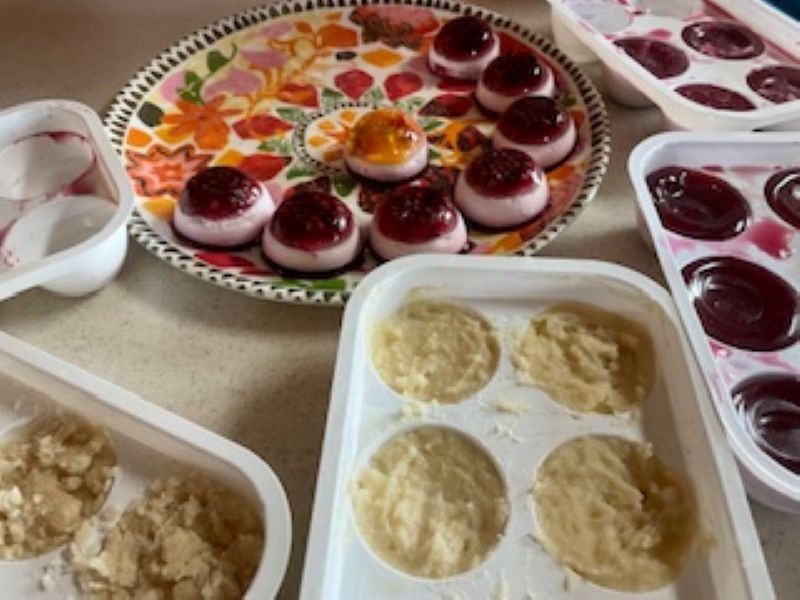
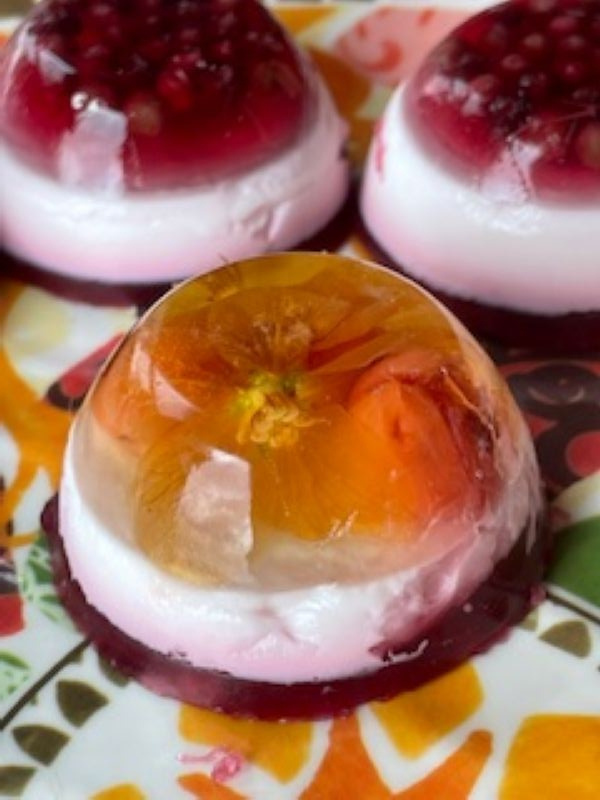

Find the Differences – Search by the Sea
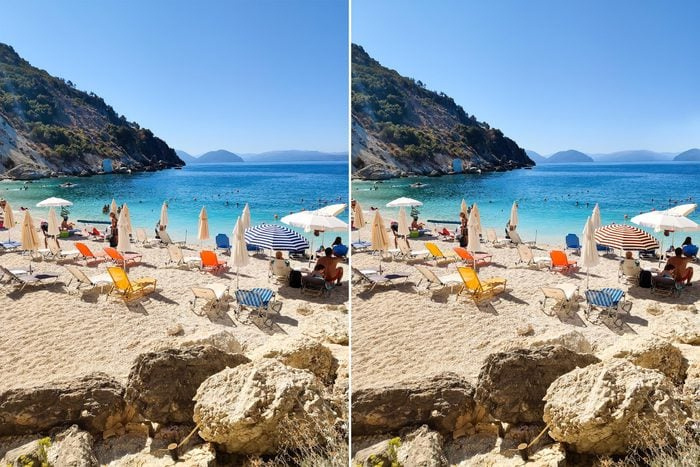
Find the five differences in the two images above.

Exploring Climax Canyon by Mauricio Meneses
Artist Mauricio Meneses (D’MAU) is creating videos highlighting sights in and around New Mexico. Visit his YouTube channel to see more. Click on the image below to go to the YouTube video.
